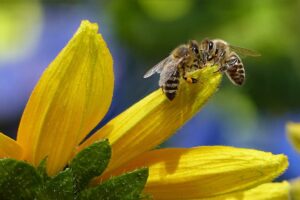Physical Address
23,24,25 & 26, 2nd Floor, Software Technology Park India, Opp: Garware Stadium,MIDC, Chikalthana, Aurangabad, Maharashtra – 431001 India
Physical Address
23,24,25 & 26, 2nd Floor, Software Technology Park India, Opp: Garware Stadium,MIDC, Chikalthana, Aurangabad, Maharashtra – 431001 India

By Aayushi Sharma
Bees are among the most important pollinators in our ecosystems, contributing significantly to the health of natural environments and human agricultural systems. Their activities facilitate the reproduction of many flowering plants, which in turn supports biodiversity and food production. However, climate change is posing a major threat to bee population globally.
Role of Bees in Ecosystem Stability and Diversity
Bees are integral to the pollination of wild plants, which make up about 90% of flowering plant species. These plants form the foundation of many ecosystems, providing habitat and food for a variety of organisms. The absence of bee pollination can lead to a decline in plant population, affecting entire ecosystems. Studies have shown that areas with healthy bee populations have greater plant diversity and abundance compared to those with declining bee numbers. Bees can be considered keystone species because their pollination activities have a disproportionate impact on their ecosystems. Thus, the decline of bee population can lead to cascading effects throughout the ecosystem.
Contribution of Bees to Biodiversity and Human Nutrition
The presence of bees supports the existence of other species that rely on the plants they pollinate. For instance, many birds, mammals, and insects depend on fruits and seeds produced through bee pollination for their survival. It is estimated that pollinators play a direct role in supplying up to 40% of the essential nutrients in the human diet. Insect pollination alone contributes to 9.5% of the total economic worth of agricultural products that are directly consumed by humans.
Impact of Climate Change on Bee Habitat
Temperature changes impact insects both directly and indirectly. Direct effects include changes in the activity levels of larvae and adults, shifts in their geographical distribution, adjustments in their phenology (the timing of life cycle events), and variations in their growth duration. Indirect effects encompass changes in host plant phenology, variations in food quality, and alterations in predator and parasite dynamics.
Bees, being ectothermic creatures, significantly depend on the temperature of their habitat for proper functioning. Honeybees and bumblebees, in particular, are essential pollinators and are known to visit over 90% of global food crops.
Climate change has been shown to drive species to higher elevations and latitudes and cause shifts in phenology.
Decline of Habitat for Himalayan Bumble Bees
There are about 53 species of Bumblebees in the Himalayas, out of which nine species are endemic to this region. Climate change poses a significant threat to ecosystems and biodiversity, potentially causing the extinction of several Himalayan species. This includes pollinating insects, whose behavior, physiology, and synchronization with host plants may be disrupted. A study done in the Great Himalayan National Park Conservation Area shows that climate change could reduce suitable habitats for bumblebees in the region. There has been no effort to integrate various climate change scenarios to quantify future habitat changes for individual bumblebee species across the Himalayas.
Dr. Priyadarsanan Dharma Rajan, an ecologist and taxonomist told CFC India that, “Bumble bees prefer higher elevation places with cool temperatures. Each degree hike in temperature has an adverse effect on the diversity of bumble bees. Similarly, to do foraging, bees need a lot of energy to collect nectar and pollinate. A rise in temperature causes them to spend a lot more energy doing these activities. This leads to their exhaustion and ultimately the bee population is lost.”
Climate change can substantially impact bee habitat, affecting the availability and suitability of feeding and nesting sites for honey bees and wild bee species. Bees are highly sensitive to environmental variables. Also, changes in temperature, precipitation, and habitat structure can disrupt their ability to identify suitable sites for residing and foraging. Here are some significant ways that climate change may affect bee habitat:
Impact of Changing Climate on Floral Resources
Changes in temperature and precipitation patterns can impact the timing, abundance, and distribution of flowering plants, which are vital sources of nectar and pollen for bees. These alterations can lead to mismatches between the peak blooming periods of flowers and the active foraging periods of bees, reducing the availability of essential floral resources. As a result, bees may struggle to find adequate food, which affects their health, reproduction, and survival.
Shifts in Plant and Bee Geographic Ranges
As temperatures rise, the geographic ranges of plants and flowers may shift. Many plants may move to higher altitudes or latitudes to find suitable growing conditions, disrupting long-standing bee-plant associations. Bees may need to follow these shifts to find sufficient food, which can alter their distribution. This movement can be particularly challenging for bees with specialized habitat requirements or limited dispersal capabilities, potentially leading to population declines.
Challenges of Habitat Fragmentation for Bee Populations
Increased habitat fragmentation due to climate change can make it more difficult for bees to find continuous habitat areas that are suitable for them. Urbanization, agricultural expansion, and infrastructural development exacerbate this fragmentation, isolating bee populations and limiting their access to food and nesting sites. Fragmented habitats can also hinder bees’ ability to disperse and recolonize areas, reducing genetic diversity and making populations more vulnerable to local extinctions.
Consequences of Native Plant Species Loss on Bees
Climate change can lead to the loss of native plant species that are crucial for bee nutrition and habitat. These plants may be unable to adapt to rapidly changing environmental conditions, leading to declines or extinctions. With fewer native feeding sources available, bees may struggle to find the necessary resources to sustain their populations.
References:
https://www.science.org/doi/10.1126/science.aaa7031
https://www.sciencedirect.com/science/article/abs/pii/S0169534710000364
https://www.sciencedirect.com/science/article/abs/pii/S0921800908002942
https://journals.plos.org/plosone/article?id=10.1371/journal.pone.0021363
https://www.nature.com/articles/s41598-024-52340-9
Photo by Hieu Hoang https://www.pexels.com/photo/macro-photography-of-bee-760162/
Photo by Pixabay https://www.pexels.com/photo/bee-sipping-nectar-on-flower-during-daytime-144252/
Photo by Ion Sebang
https://www.pexels.com/photo/yellow-and-black-bees-on-brown-and-black-textile-3194327
Comments are closed.
b7i5sv